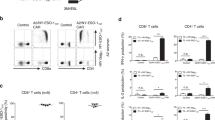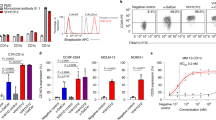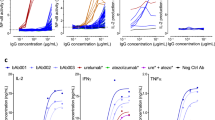Abstract
The activation of T cells plays a central role in antitumor immunity. In order to activate naïve T cells, two key signals are required. Signal one is provided through the T-cell receptor (TCR) while signal two is that of costimulation. The CD28:B7 molecules are one of the best-studied costimulatory pathways, thought to be the main mechanism through which primary T-cell stimulation occurs. However, a number of molecules have been identified which serve to amplify and diversify the T-cell response, following initial T-cell activation. These include the more recently described 4-1BB:4-1BB ligand (4-1BBL) molecules. 4-1BB:4-1BBL are a member of the TNFR:TNF ligand family, which are expressed on T cells and antigen-presenting cells (APCs), respectively. Therapies utilizing the 4-1BB:4-1BBL signaling pathway have been shown to have antitumor effects in a number of model systems. In this paper, we focus on the 4-1BB:4-1BBL costimulatory molecules. In particular, we will describe the structure and function of the 4-1BB molecule, its receptor and how 4-1BB:4-1BBL costimulation has and may be used for the immunotherapy of cancer.
This is a preview of subscription content, access via your institution
Access options
Subscribe to this journal
Receive 12 print issues and online access
$259.00 per year
only $21.58 per issue
Buy this article
- Purchase on Springer Link
- Instant access to full article PDF
Prices may be subject to local taxes which are calculated during checkout



Similar content being viewed by others
References
Lafferty KJ, Cunningham AJ . A new analysis of allogeneic interactions. Aust J Exp Biol Med Sci. 1975;53:27–42.
Carreno BM, Collins M . The B7 family of ligands and its receptors: new pathways for costimulation and inhibition of immune responses. Annu Rev Immunol. 2002;20:29–53.
Chambers CA, Allison JP . Costimulatory regulation of T cell function. Curr Opin Cell Biol. 1999;11:203–210.
Tai XG, Toyooka K, Yashiro Y, et al. CD9-mediated costimulation of TCR-triggered naive T cells leads to activation followed by apoptosis. J Immunol. 1997;159:3799–3807.
Yashiro Y, Tai XG, Toyo-Oka K, et al. A fundamental difference in the capacity to induce proliferation of naive T cells between CD28 and other co-stimulatory molecules. Eur J Immunol. 1998;28:926–935.
Zuckerman LA, Pullen L, Miller J . Functional consequences of costimulation by ICAM-1 on IL-2 gene expression and T cell activation. J Immunol. 1998;160:3259–3268.
Lenschow DJ, Walunas TL, Bluestone JA . CD28/B7 system of T cell costimulation. Annu Rev Immunol. 1996;14:233–258.
Chambers CA, Allison JP . Co-stimulation in T cell responses. Curr Opin Immunol. 1997;9:396–404.
Watts TH, DeBenedette MA . T cell co-stimulatory molecules other than CD28. Curr Opin Immunol. 1999;11:286–293.
Kwon BS, Weissman SM . cDNA sequences of two inducible T-cell genes. Proc Natl Acad Sci USA. 1989;86:1963–1967.
Kwon BS, Kozak CA, Kim KK, Pickard RT . Genomic organization and chromosomal localization of the T-cell antigen 4-1BB. J Immunol. 1994;152:2256–2262.
Schwarz H, Tuckwell J, Lotz M . A receptor induced by lymphocyte activation (ILA): a new member of the human nerve-growth-factor/tumor-necrosis-factor receptor family. Gene. 1993;134:295–298.
Alderson MR, Smith CA, Tough TW, et al. Molecular and biological characterization of human 4-1BB and its ligand. Eur J Immunol. 1994;24:2219–2227.
Schwarz H, Arden K, Lotz M . CD137, a member of the tumor necrosis factor receptor family, is located on chromosome 1p36, in a cluster of related genes, and colocalizes with several malignancies. Biochem Biophys Res Commun. 1997;235:699–703.
Zhou Z, Kim S, Hurtado J, et al. Characterization of human homologue of 4-1BB and its ligand. Immunol Lett. 1995;45:67–73.
Goodwin RG, Din WS, Davis-Smith T, et al. Molecular cloning of a ligand for the inducible T cell gene 4-1BB: a member of an emerging family of cytokines with homology to tumor necrosis factor. Eur J Immunol. 1993;23:2631–2641.
Kwon BS, Kestler DP, Eshhar Z, Oh KO, Wakulchik M . Expression characteristics of two potential T cell mediator genes. Cell Immunol. 1989;121:414–422.
Schwarz H, Valbracht J, Tuckwell J, von Kempis J, Lotz M . ILA, the human 4-1BB homologue, is inducible in lymphoid and other cell lineages. Blood. 1995;85:1043–1052.
Vinay DS, Kwon BS . Role of 4-1BB in immune responses. Semin Immunol. 1998;10:481–489.
Pollok KE, Kim YJ, Zhou Z, et al. Inducible T cell antigen 4-1BB. Analysis of expression and function. J Immunol. 1993;150:771–781.
Pollok KE, Kim YJ, Hurtado J, et al. 4-1BB T-cell antigen binds to mature B cells and macrophages, and costimulates anti-mu-primed splenic B cells. Eur J Immunol. 1994;24:367–374.
Melero I, Johnston JV, Shufford WW, Mittler RS, Chen L . NK1.1 cells express 4-1BB (CDw137) costimulatory molecule and are required for tumor immunity elicited by anti-4-1BB monoclonal antibodies. Cell Immunol. 1998;190:167–172.
Futagawa T, Akiba H, Kodama T, et al. Expression and function of 4-1BB and 4-1BB ligand on murine dendritic cells. Int Immunol. 2002;14:275–286.
Heinisch IV, Daigle I, Knopfli B, Simon HU . CD137 activation abrogates granulocyte–macrophage colony-stimulating factor-mediated anti-apoptosis in neutrophils. Eur J Immunol. 2000;30:3441–3446.
Lindstedt M, Johansson-Lindbom B, Borrebaeck CA . Expression of CD137 (4-1BB) on human follicular dendritic cells. Scand J Immunol. 2003;57:305–310.
Kienzle G, von Kempis J . CD137 (ILA/4-1BB), expressed by primary human monocytes, induces monocyte activation and apoptosis of B lymphocytes. Int Immunol. 2000;12:73–82.
Broll K, Richter G, Pauly S, Hofstaedter F, Schwarz H . CD137 expression in tumor vessel walls. High correlation with malignant tumors. Am J Clin Pathol. 2001;115:543–549.
Michel J, Langstein J, Hofstadter F, Schwarz H . A soluble form of CD137 (ILA/4-1BB), a member of the TNF receptor family, is released by activated lymphocytes and is detectable in sera of patients with rheumatoid arthritis. Eur J Immunol. 1998;28:290–295.
Kim KM, Kim HW, Kim JO, et al. Induction of 4-1BB (CD137) expression by DNA damaging agents in human T lymphocytes. Immunology. 2002;107:472–479.
Kim JO, Kim HW, Baek KM, Kang CY . NF-kappaB and AP-1 regulate activation-dependent CD137 (4-1BB) expression in T cells. FEBS Lett. 2003;541:163–170.
Turka LA, Ledbetter JA, Lee K, June CH, Thompson CB . CD28 is an inducible T cell surface antigen that transduces a proliferative signal in CD3+ mature thymocytes. J Immunol. 1990;144:1646–1653.
Gavin MA, Clarke SR, Negrou E, Gallegos A, Rudensky A . Homeostasis and anergy of CD4(+)CD25(+) suppressor T cells in vivo. Nat Immunol. 2002;3:33–41.
McHugh RS, Shevach EM . Cutting edge: depletion of CD4+CD25+ regulatory T cells is necessary, but not sufficient, for induction of organ-specific autoimmune disease. J Immunol. 2002;168:5979–5983.
DeBenedette MA, Shahinian A, Mak TW, Watts TH . Costimulation of CD28- T lymphocytes by 4-1BB ligand. J Immunol. 1997;158:551–559.
Salih HR, Schmetzer HM, Burke C, et al. Soluble CD137 (4-1BB) ligand is released following leukocyte activation and is found in sera of patients with hematological malignancies. J Immunol. 2001;167:4059–4066.
Salih HR, Kosowski SG, Haluska VF, et al. Constitutive expression of functional 4-1BB (CD137) ligand on carcinoma cells. J Immunol. 2000;165:2903–2910.
Lenschow DJ, Ho SC, Sattar H, et al. Differential effects of anti-B7-1 and anti-B7-2 monoclonal antibody treatment on the development of diabetes in the nonobese diabetic mouse. J Exp Med. 1995;181:1145–1155.
Bertram EM, Lau P, Watts TH . Temporal segregation of 4-1BB versus CD28-mediated costimulation: 4-1BB ligand influences T cell numbers late in the primary response and regulates the size of the T cell memory response following influenza infection. J Immunol. 2002;168:3777–3785.
Kwon BS, Hurtado JC, Lee ZH, et al. Immune responses in 4-1BB (CD137)-deficient mice. J Immunol. 2002;168:5483–5490.
Cannons JL, Choi Y, Watts TH . Role of TNF receptor-associated factor 2 and p38 mitogen-activated protein kinase activation during 4-1BB-dependent immune response. J Immunol. 2000;165:6193–6204.
Cannons JL, Lau P, Ghumman B, et al. 4-1BB ligand induces cell division, sustains survival, and enhances effector function of CD4 and CD8 T cells with similar efficacy. J Immunol. 2001;167:1313–1324.
Wen T, Bukczynski J, Watts TH . 4-1BB ligand-mediated costimulation of human T cells induces CD4 and CD8 T cell expansion, cytokine production, and the development of cytolytic effector function. J Immunol. 2002;168:4897–4906.
Shuford WW, Klussman K, Tritchler DD, et al. 4-1BB costimulatory signals preferentially induce CD8+ T cell proliferation and lead to the amplification in vivo of cytotoxic T cell responses. J Exp Med. 1997;186:47–55.
Lee HW, Park SJ, Choi BK, et al. 4-1BB promotes the survival of CD8+ T lymphocytes by increasing expression of Bcl-xL and Bfl-1. J Immunol. 2002;169:4882–4888.
Kim YJ, Brutkiewicz RR, Broxmeyer HE . Role of 4-1BB (CD137) in the functional activation of cord blood CD28(-) CD8(+) T cells. Blood. 2002;100:3253–3260.
Laderach D, Movassagh M, Johnson A, Mittler RS, Galy A . 4-1BB co-stimulation enhances human CD8(+) T cell priming by augmenting the proliferation and survival of effector CD8(+) T cells. Int Immunol. 2002;14:1155–1167.
Melero I, Shuford WW, Newby SA, et al. Monoclonal antibodies against the 4-1BB T-cell activation molecule eradicate established tumors. Nat Med. 1997;3:682–685.
Wiethe C, Dittmar K, Doan T, Lindenmaier W, Tindle R . Provision of 4-1BB ligand enhances effector and memory CTL responses generated by immunization with dendritic cells expressing a human tumor-associated antigen. J Immunol. 2003;170:2912–2922.
Giuntoli RL, Lu J, Kobayashi H, Kennedy R, Celis E . Direct costimulation of tumor-reactive CTL by helper T cells potentiate their proliferation, survival, and effector function. Clin Cancer Res. 2002;8:922–931.
Langstein J, Michel J, Fritsche J, et al. CD137 (ILA/4-1BB), a member of the TNF receptor family, induces monocyte activation via bidirectional signaling. J Immunol. 1998;160:2488–2494.
Zhu G, Flies DB, Tamada K, et al. Progressive depletion of peripheral B lymphocytes in 4-1BB (CD137) ligand/I-Ealpha)-transgenic mice. J Immunol. 2001;167:2671–2676.
Martinet O, Ermekova V, Qiao JQ, et al. Immunomodulatory gene therapy with interleukin 12 and 4-1BB ligand: long-term remission of liver metastases in a mouse model. J Natl Cancer Inst. 2000;92:931–936.
Wilcox RA, Chapoval AI, Gorski KS, et al. Cutting edge: expression of functional CD137 receptor by dendritic cells. J Immunol. 2002;168:4262–4267.
Kwon B, Lee HW, Kwon BS . New insights into the role of 4-1BB in immune responses: beyond CD8+ T cells. Trends Immunol. 2002;23:378–380.
DeBenedette MA, Wen T, Bachmann MF, et al. Analysis of 4-1BB ligand (4-1BBL)-deficient mice and of mice lacking both 4-1BBL and CD28 reveals a role for 4-1BBL in skin allograft rejection and in the cytotoxic T cell response to influenza virus. J Immunol. 1999;163:4833–4841.
Tan JT, Whitmire JK, Murali-Krishna K, et al. 4-1BB costimulation is required for protective anti-viral immunity after peptide vaccination. J Immunol. 2000;164:2320–2325.
Hurtado JC, Kim SH, Pollok KE, Lee ZH, Kwon BS . Potential role of 4-1BB in T cell activation. Comparison with the costimulatory molecule CD28. J Immunol. 1995;155:3360–3367.
Hurtado JC, Kim YJ, Kwon BS . Signals through 4-1BB are costimulatory to previously activated splenic T cells and inhibit activation-induced cell death. J Immunol. 1997;158:2600–2609.
Kim YJ, Kim SH, Mantel P, Kwon BS . Human 4-1BB regulates CD28 co-stimulation to promote Th1 cell responses. Eur J Immunol. 1998;28:881–890.
Bukczynski J, Wen T, Watts TH . Costimulation of human. Eur J Immunol. 2003;33:446–454.
Guinn BA, Bertram EM, DeBenedette MA, Berinstein NL, Watts TH . 4-1BBL enhances anti-tumor responses in the presence or absence of CD28 but CD28 is required for protective immunity against parental tumors. Cell Immunol. 2001;210:56–65.
Moingeon P . Cancer vaccines. Vaccine. 2001;19:1305–1326.
Pardoll D . Releasing the brakes on antitumor immune response. Science. 1996;271:1691.
Antonia SJ, Seigne J, Diaz J, et al. Phase I trial of a B7-1 (CD80) gene modified autologous tumor cell vaccine in combination with systemic interleukin-2 in patients with metastatic renal cell carcinoma. J Urol. 2002;167:1995–2000.
Horig H, Lee DS, Conkright W, et al. Phase I clinical trial of a recombinant canarypoxvirus (ALVAC) vaccine expressing human carcinoembryonic antigen and the B7.1 co-stimulatory molecule. Cancer Immunol Immunother. 2000;49:504–514.
von Mehren M, Arlen P, Tsang KY, et al. Pilot study of a dual gene recombinant avipox vaccine containing both carcinoembryonic antigen (CEA) and B7.1 transgenes in patients with recurrent CEA-expressing adenocarcinomas. Clin Cancer Res. 2000;6:2219–2228.
Lum LG, LeFever AV, Treisman JS, Garlie NK, Hanson Jr JP . Immune modulation in cancer patients after adoptive transfer anti-CD3/anti-CD28-costimulate T cell-phase I clinical trial. J Immunother. 2001;24:408–419.
Manzke O, Tesch H, Lorenzen J, Diehl V, Bohlen H . Locoregional treatment of low-grade B-cell lymphoma with CD3xCD19 bispecific antibodies and CD28 costimulation. II. Assessment of cellular immune response. Int J Cancer. 2001;91:516–522.
Whitton JL, Fujinami RS . Viruses as triggers of autoimmunity: facts and fantasies. Curr Opin Microbiol. 1999;2:392–397.
Myers L, Takahashi C, Mittler RS, Rossi RJ, Vella AT . Effector CD8T cells possess suppressor function after 4-1BB and Toll-like receptor triggering. Proc Natl Acad Sci USA. 2003;100:5348–5353.
Dudley ME, Wunderlich JR, Robbins PF, et al. Cancer regression and autoimmunity in patients after clonal repopulation with antitumor lymphocytes. Science. 2002;298:850–854.
Strome SE, Martin B, Flies D, et al. Enhanced therapeutic potential of adoptive immunotherapy by in vitro CD28/4-1BB costimulation of tumor-reactive T cells against a poorly immunogenic, major histocompatibility complex class I-negative A9P melanoma. J Immunother. 2000;23:430–437.
Li Q, Carr A, Ito F, Teitz-Tennenbaum S, Chang AE . Polarization effects of 4-1BB during CD28 costimulation in generating tumor-reactive T cells for cancer immunotherapy. Cancer Res. 2003;63:2546–2552.
Ho WY, Yee C, Greenberg PD . Adoptive therapy with CD8(+) T cells: it may get by with a little help from its friends. J Clin Invest. 2002;110:1415–1417.
Kim JA, Averbook BJ, Chambers K, et al. Divergent effects of 4-1BB antibodies on antitumor immunity and on tumor-reactive T-cell generation. Cancer Res. 2001;61:2031–2037.
Chen SH, Pham-Nguyen KB, Martinet O, et al. Rejection of disseminated metastases of colon carcinoma by synergism of IL-12 gene therapy and 4-1BB costimulation. Mol Ther. 2000;2:39–46.
Martinet O, Divino CM, Zang Y, et al. T cell activation with systemic agonistic antibody versus local 4-1BB ligand gene delivery combined with interleukin-12 eradicate liver metastases of breast cancer. Gene Ther. 2002;9:786–792.
Melero I, Bach N, Hellstrom KE, et al. Amplification of tumor immunity by gene transfer of the co-stimulatory 4-1BB ligand: synergy with the CD28 co-stimulatory pathway. Eur J Immunol. 1998;28:1116–1121.
Mittler RS, Bailey TS, Klussman K, Trailsmith MD, Hoffmann MK . Anti-4-1BB monoclonal antibodies abrogate T cell-dependent humoral immune responses in vivo through the induction of helper T cell anergy. J Exp Med. 1999;190:1535–1540.
Hellstrom KE, Hellstrom I . Therapeutic vaccination with tumor cells that engage CD137. J Mol Med. 2003;81:71–86.
Guinn BA, DeBenedette MA, Watts TH, Berinstein NL . 4-1BBL cooperates with B7-1 and B7-2 in converting a B cell lymphoma cell line into a long-lasting antitumor vaccine. J Immunol. 1999;162:5003–5010.
Mogi S, Sakurai J, Kohsaka T, et al. Tumour rejection by gene transfer of 4-1BB ligand into a CD80(+) murine squamous cell carcinoma and the requirements of co-stimulatory molecules on tumour and host cells. Immunology. 2000;101:541–547.
Xiang J . Expression of co-stimulatory 4-1BB ligand induces significant tumor regression and protective immunity. Cancer Biother Radiopharm. 1999;14:353–361.
Ye Z, Hellstrom I, Hayden-Ledbetter M, et al. Gene therapy for cancer using single-chain Fv fragments specific for 4-1BB. Nat Med. 2002;8:343–348.
Smythe JA, Fink PD, Logan GJ, et al. Human fibroblasts transduced with CD80 or CD86 efficiently trans-costimulate CD4+ and CD8+ T lymphocytes in HLA-restricted reactions: implications for immune augmentation cancer therapy and autoimmunity. J Immunol. 1999;163:3239–3249.
Acknowledgements
We would like to thank Professor Farzin Farzaneh for his suggestions and the Departments of Haematological Medicine and Molecular Medicine for their support. BG is funded by the Leukaemia Research Fund.
Author information
Authors and Affiliations
Corresponding author
Rights and permissions
About this article
Cite this article
Cheuk, A., Mufti, G. & Guinn, Ba. Role of 4-1BB:4-1BB ligand in cancer immunotherapy. Cancer Gene Ther 11, 215–226 (2004). https://doi.org/10.1038/sj.cgt.7700670
Received:
Published:
Issue Date:
DOI: https://doi.org/10.1038/sj.cgt.7700670
Keywords
This article is cited by
-
Long-term antigen-specific immune response by an oncolytic adenovirus encoding SP-SA-E7-4-1BBL in HPV-16 cancer model
Molecular Biology Reports (2024)
-
4-1BB-4-1BBL cis-interaction contributes to the survival of self-reactive CD8+ T cell
Cellular & Molecular Immunology (2023)
-
Normofractionated irradiation and not temozolomide modulates the immunogenic and oncogenic phenotype of human glioblastoma cell lines
Strahlentherapie und Onkologie (2023)
-
Combination Immunotherapy Strategies in Breast Cancer
Current Breast Cancer Reports (2019)
-
Novel Immunotherapy Combinations
Current Oncology Reports (2019)



